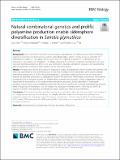Natural combinatorial genetics and prolific polyamine production enable siderophore diversification in Serratia plymuthica
Author(s)
Cleto, Sara; Haslinger, Kristina; Prather, Kristala L J; Lu, Timothy K
Download12915_2021_Article_971.pdf (2.055Mb)
Publisher with Creative Commons License
Publisher with Creative Commons License
Creative Commons Attribution
Terms of use
Metadata
Show full item recordAbstract
Abstract
Background
Iron is essential for bacterial survival. Bacterial siderophores are small molecules with unmatched capacity to scavenge iron from proteins and the extracellular milieu, where it mostly occurs as insoluble Fe3+. Siderophores chelate Fe3+ for uptake into the cell, where it is reduced to soluble Fe2+. Siderophores are key molecules in low soluble iron conditions. The ability of bacteria to synthesize proprietary siderophores may have increased bacterial evolutionary fitness; one way that bacteria diversify siderophore structure is by incorporating different polyamine backbones while maintaining the catechol moieties.
Results
We report that Serratia plymuthica V4 produces a variety of siderophores, which we term the siderome, and which are assembled by the concerted action of enzymes encoded in two independent gene clusters. Besides assembling serratiochelin A and B with diaminopropane, S. plymuthica utilizes putrescine and the same set of enzymes to assemble photobactin, a siderophore found in the bacterium Photorhabdus luminescens. The enzymes encoded by one of the gene clusters can independently assemble enterobactin. A third, independent operon is responsible for biosynthesis of the hydroxamate siderophore aerobactin, initially described in Enterobacter aerogenes. Mutant strains not synthesizing polyamine-siderophores significantly increased enterobactin production levels, though lack of enterobactin did not impact the production of serratiochelins. Knocking out SchF0, an enzyme involved in the assembly of enterobactin alone, significantly reduced bacterial fitness.
Conclusions
This study shows the natural occurrence of serratiochelins, photobactin, enterobactin, and aerobactin in a single bacterial species and illuminates the interplay between siderophore biosynthetic pathways and polyamine production, indicating routes of molecular diversification. Given its natural yields of diaminopropane (97.75 μmol/g DW) and putrescine (30.83 μmol/g DW), S. plymuthica can be exploited for the industrial production of these compounds.
Date issued
2021-03-15Department
Massachusetts Institute of Technology. Department of Electrical Engineering and Computer Science; Massachusetts Institute of Technology. Department of Biological Engineering; Massachusetts Institute of Technology. Synthetic Biology Center; Massachusetts Institute of Technology. Department of Chemical EngineeringPublisher
BioMed Central
Citation
BMC Biology. 2021 Mar 15;19(1):46
Version: Final published version